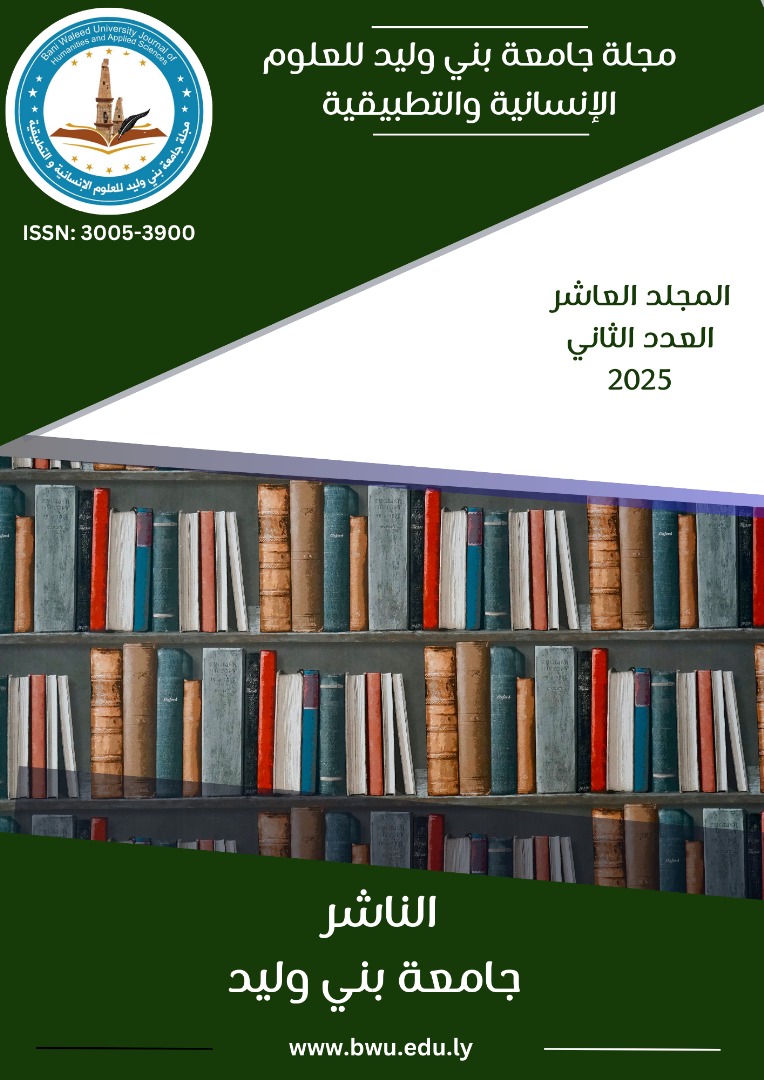A study on the damage caused by the incorrect disposal of used engine exhaust oils and their impact on pollution in the Libyan environment
DOI:
https://doi.org/10.58916/jhas.v10i2.771Keywords:
Environmental pollution, used engine oil, recycling, groundwater, environmental sustainability.Abstract
Environmental pollution caused by used engine oil in Libya is a serious issue that directly impacts public health and ecological balance. This pollution results from improper disposal methods, such as discharging used oil into soil or water sources, leading to soil and groundwater contamination. Additionally, it contributes to climate change by releasing harmful pollutants into the environment. This study aims to highlight the sources of pollution from used engine oil and analyze its environmental and health effects on humans and other living organisms. It also explores possible solutions to address this issue, including modern recycling techniques and sustainable approaches for used oil management. A descriptive and analytical methodology was adopted to examine this problem, supported by charts and tables illustrating the extent of pollution and its various impacts. The study also reviews past and current experiences in waste oil management, emphasizing the challenges faced in treatment processes in Libya. Furthermore, the study evaluates the effectiveness of environmental policies in Libya and their efficiency in reducing pollution caused by used oil. Finally, it presents a set of recommendations aimed at improving waste oil management and promoting environmental sustainability through innovative and effective solutions.
Downloads
References
Smith, J., et al. (2020). Environmental Pollution and Its Impact on Public Health. Environmental Research Journal.
WHO (2018). World Health Report on Pollution and Health. World Health Organization.
EPA (2019). Used Oil Management and Environmental Risks. Environmental Protection Agency.
UNEP (2021). Global Trends in Waste Oil Recycling and Management. United Nations Environment Programme.
Garcia, L., et al. (2022). Advances in Waste Oil Recycling Technologies. Journal of Sustainable Environmental Science.
Jones, R., & Brown, M. (2020). Mathematical Modeling of Oil Spill Contamination. Journal of Environmental Studies.
Ahmed et al., 2020. "A Study on the Effect of Used Oils on Soil Fertility." Sustainable Agriculture Journal.
Al-Otaibi, 2021. "The Impact of Oil Pollution on Biological Activity in Soil." Environmental Journal.
Al-Hashimi, 2019. "Effects of Oil Spills on Soil Properties." Environmental Science Journal.
Al-Rousi, 2022. "Heavy Metals and Their Impact on Microorganisms in Soil." Environmental Chemistry Journal.
Al-Bakri, 2021. "Pollutant Transfer from Soil to Groundwater." Environment and Development Journal.
Al-Sinai, 2020. "Technical Study on Used Oil Recycling." Environmental Engineering Journal.
Al-Maktabi, 2021. "Proper Disposal Practices of Used Oils in Libya." Waste Management Journal.
Al-Shammari, 2019. "The Use of Microorganisms in Oil Degradation." Biotechnology Journal.
Al-Khatib, 2022. "Environmental Management and the Challenges of Oil Pollution." Environmental Research Journal.
U.S. Environmental Protection Agency (EPA). (2022). Used Motor Oil: Environmental Impacts and Recycling Strategies. EPA Report No. 2022-10
"Ath-Thuraya" was published in Al-Majalla Al-Jami'a, the journal issued by the University of Zawiya, in Volume 23, Issue 4, in December 2021, from pages 61 to 76. This study was conducted by researchers: Abdelmajid Al-Bashir Abdullah, Salem Abdullah Sakal, and Khaled Ahmed Al-Fard.
Abdelaziz, M., et al. (2022). Recycling and re-refining of used lubricating oils: Challenges and opportunities.
Journal of Environmental Management. Al-Haj, L., et al. (2017). Energy efficiency and emission reduction in re-refined lubricant oils.
Renewable Energy. Bhaskar, T., et al. (2020). Pyrolysis and hydroprocessing technologies for waste oil recycling. Energy Conversion and Management.
Farooq, M., et al. (2021). Thermal and catalytic processing of used lubricants. Journal of Cleaner Production.
Hamad, A., et al. (2018). Sustainable approaches to used oil recycling. Waste Management & Research.
Jafari, A., et al. (2021). Economic impact assessment of waste oil recycling industries. Environmental Science & Policy.
Sharma, R., et al. (2019). Filtration and purification techniques in used oil re-refining. Process Safety and Environmental Protection.
Singh, R., & Agarwal, A. (2018). Advancements in used oil refining technologies. Chemical Engineering Journal.
USEPA (United States Environmental Protection Agency). (2019). Used oil management: Environmental and economic benefits.
U.S. DOE (Department of Energy). (2021). Sustainable oil recycling and energy conservation.
Wu, Y., et al. (2020). Catalytic hydroprocessing of used lubricants. Fuel Processing Technology. Com
almerja .https://www[29]
. eg. org. gate . gate ahram.https://www[30]
Source: United States Environmental Protection Agency (EPA), 2021.
The World Health Organization (WHO) has published several reports addressing the health impacts of water pollution. While there isn't a specific 2022 report solely focused on the health effects of water pollution by used oils, WHO's publications on water safety and quality provide relevant insights.
National Academy of Sciences, 2023.
https://www dspace.zu.edu.ly
Openknowledge.fao.org. https://www[35]
Siddiquee, M. N., et al. (2011). The effects of waste oil disposal on environment and predictive analysis of engine oil life cycle for sustainability. Renewable and Sustainable Energy Reviews, 15(6), 2825-2831.
Martín-Gómez, A., et al. (2016). Waste oil recycling: An analysis of the environmental and economic impact. Journal of Cleaner Production, 112, 4625-4633.
Al-Ghouti, M. A., & Al-Atoum, L. (2009). Virgin and recycled engine oil differentiation: A spectroscopic study. Journal of Environmental Management, 90(1), 187-195.
Norrby, T. (2003). Environmentally adapted lubricants—where are the opportunities? Tribology International, 36(8), 547-553.
Fakhru’l-Razi, A., et al. (2009). Review of technologies for oil and gas produced water treatment. Journal of Hazardous Materials, 170(2-3), 530-551.
Kannan, C., et al. (2014). Environmental impact of used engine oil disposal on soil properties. Procedia Environmental Sciences, 20, 317-324.
Udonne, J. D. (2011). A comparative study of recycling of used lubricating oils using distillation, acid, and activated charcoal with clay methods. Journal of Petroleum Technology and Alternative Fuels, 2(2), 35-43.
Demirbas, A. (2009). Waste oil management: Recovery of heavy metals from waste lubricating oil. Energy Sources, Part A: Recovery, Utilization, and Environmental Effects, 31(16), 1426-1432.
Ogbeide, O. (2010). An investigation to the recycling of spent lubricating oil. Journal of Engineering Science and Technology, 5(4), 435-446.









